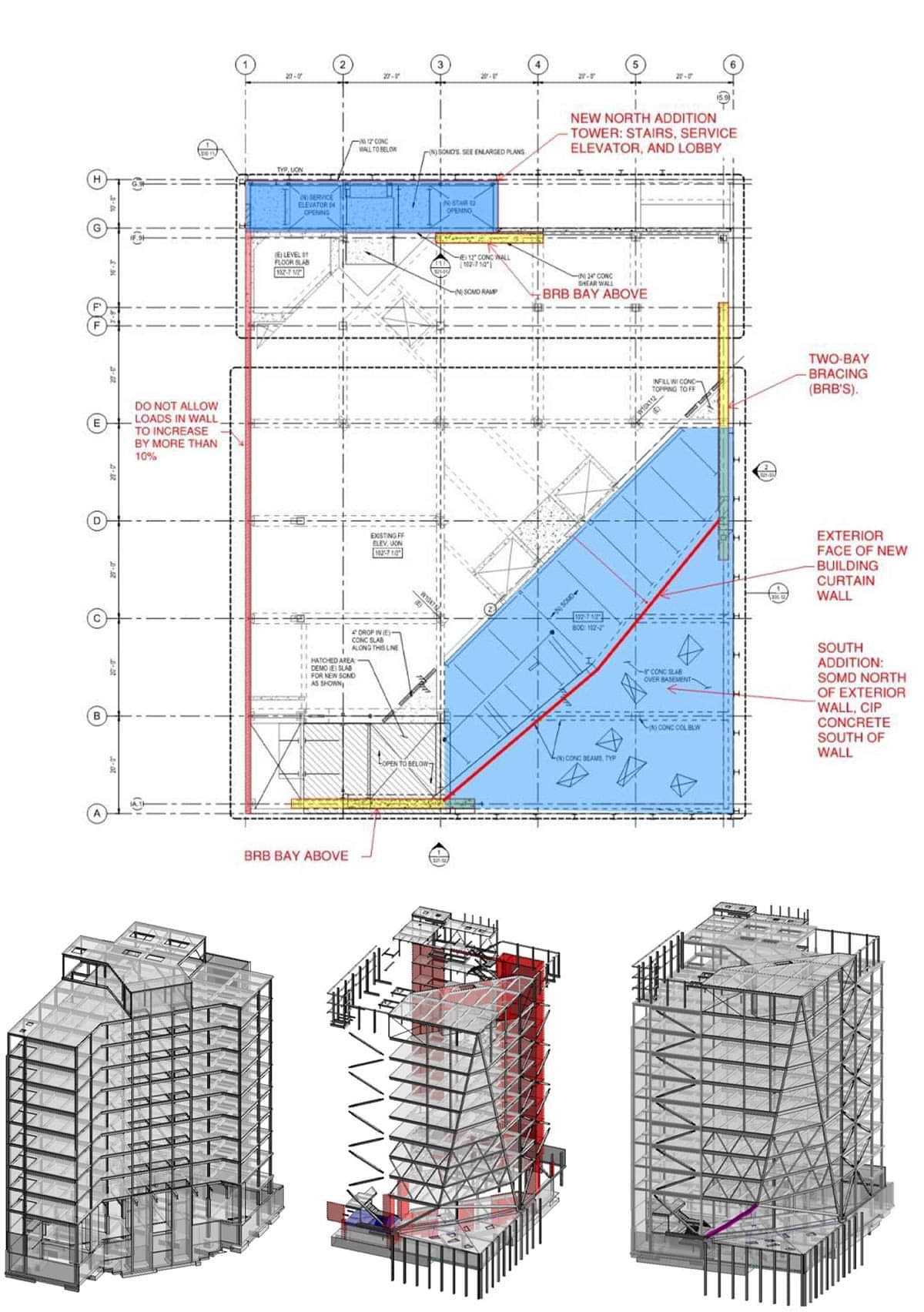rchitects and engineers are two related professions that frequently get lumped together. How many casual conversations have declared a building, roadway, transportation, or utility system an “architectural” or “engineering” feat, interchangeably? To some degree, both deserve credit; an architect and engineer likely worked together on any given project. However, these two fields approach a project from different perspectives and tackle specific problems to deliver a finished product with both style and substance.
Hopper describes architects as visionaries for the project who observe shapes and forms from the project environment and the culture of the end-users then creatively melds those ideas into an artistic solution. Engineers, on the other hand, work in a world with numerical limits and a library of workable solutions. He says engineers’ creativity becomes apparent as they stretch those workable solutions to meet the challenges of the architectural vision.
Those key differences start with their education. Giovanna Gambardella, senior architect and architectural service manager for Stantec, says architects are regulated by the Alaska State Board of Architects, Engineers, and Land Surveyors. To be licensed as a professional architect in Alaska, a candidate must pass the Architect Registration Examination (ARE), achieve professional experience hours through the Intern Development Program, and complete the Arctic Engineering or Northern Design class.
“There are additional certifications like LEED, WELL, and CDT,” says Gambardella. “These are certifications that are tailored to various aspects of our industry and focus on certain areas of the profession. For instance, LEED certification was developed by the US Green Building Council and is recognized internationally. A LEED building means it’s designed to be environmentally friendly and energy and resource efficient.”
Engineers have their own path toward licensing. After acquiring a college degree from an accredited engineering program, candidates embark on four years of work experience under a registered engineer. A candidate must then pass the Principles and Practice of Engineering (PE) exam. Jason Thoma, senior mechanical engineer for Stantec in Fairbanks, says once an engineer passes the PE exam is passed, they are officially licensed by the state to practice in their field.
Senior Structural Engineer
Stantec
The two professions diverge further as architects and engineers specialize. Architects can further be divided into commercial, residential, sustainable/green design, industrial, conservation, landscape, and urban design architecture. When it comes to vertical construction, Thoma says you will generally find more building architects, who are concerned with the general look and feel of the entire structure; interior design architects, who come up with color schemes and finishes for inside the structure; and landscape architects who craft the property around the building.
Though structural, mechanical, and electrical engineers are the most common in vertical construction, Hopper says it’s not uncommon to have engineers specializing in acoustic and corrosion engineering join a project. Horizontal construction for bridges, roads, highways, railroads, airfields, and other structural projects that focus on transportation often requires additional engineering specialties such as civil, environmental, and geotechnical.
“It can be a nightmare if the structural [engineer] is told to do a structural system designed by an architect. That is often more challenging than a structural engineer designing the structure and having the architect modify it,” says Michael Fierro, associate principal at Reid Middleton and the structural engineer of record on the renovation of 601 West Fifth, the former KeyBank building in downtown Anchorage.
For that project, the dream is a glacier-themed design plus more rentable square footage. Kirk Malanchuk, project architect with Perkins&Will in Seattle, came up with a design that enlarges the L-shaped building by widening the top floors, such that they overhang the plaza below.
“They didn’t want any columns out there,” Fierro says, “so I had to figure out how to get that load back into the existing foundations, which were not going to have the capacity to take the extra load. So we actually had to build up the existing foundations.”
Malanchuk acknowledges that building foundations underneath the nine-story tower is, of course, backward. “How do you do all of that when there’s already footings down there? When there’s already a stair that extends down to that level? If you’re starting to add footings that extend below parts of the building that have already been built, that requires a certain amount of demolition, excavation, shoring, stuff that you wouldn’t necessarily have to do to the same extent with new construction.”
But the columnless entry was non-negotiable. “With the aesthetics they wanted, it created some really intense structural challenges,” Fierro says. “I just had to figure out how to hold it up.”
Even though he and Fierro come from different firms, Malanchuk had faith that the engineers would find a solution. “Working with Reid Middleton, they’re more than capable of taking this on,” he says, “but it’s not a building form that they could necessarily look back on past projects to completely help inform.”
In turn, Fierro says Malanchuk has been a good listener, and the overall vision will outlast the difficulties in executing it. “Ten years from now, nobody’s gonna remember that,” he says. “They’re gonna look and say, ‘Wow, that’s a really cool façade.’”
Working on a project through different firms allows both the architect and engineer more opportunities to work with others in their respective fields but requires developing a rapport with a business entity that has its own processes, philosophies, and culture. Having separate firms manage the architectural design and engineering of a project is about as common as having both handled by the same company. Having architects and engineers under the same roof provides a shared business culture but risks losing another viewpoint on the project. Regardless of the situation, architects and engineers agree that it takes good communication for both fields to work together successfully.
Reid Middleton
Reid Middleton

Teams can also communicate using design platforms such as Revit, which allows all models to be linked so that designers can coordinate among each other and the client. Likewise, Stantec teams also use virtual reality to communicate design concepts, especially with those who don’t speak the language of architecture and engineering every day.
Hopper says that architects and engineers eventually work together like the left hand working with the right hand, where each unconsciously knows what is expected for their portion of the project. On that note, Gambardella says the structure is not an obstacle to the aesthetic but a way to enhance it.
“It isn’t about architect versus engineer,” she says. “It’s about the holistic approach.”
“We both use input from the stakeholders, personal knowledge, and input from the team to develop a design that will meet the owner’s needs, schedule, and budget,” says Schneller.
In general, projects with architectural design are typically led by an architect, while projects conceptualized by a designer or engineer (roadways, utilities, airfields) are often led by an engineer. However, Schneller explains this assignment of leadership isn’t a hard and fast rule; engineers can dream, too.
For example, Fierro worked on the skybridge over Providence Drive between the UAA Engineering and Health Sciences Nursing buildings, which opened in 2015. He recalls the architecture firm told him, “‘To us this is just one long room that we’re gonna carpet. This is way out of our league. You come up with the designs.’ I said OK. So we actually presented UAA with three different options… they loved that arched one.”
When it comes to large projects, Hopper believes project management should fall on someone who is not responsible for any technical aspect of design. He says the project management role demands so much attention that there is no time left for that person also to take on additional technical duties.
Of course, having a team that includes an architect and engineer increases project costs. Budget limitations may tempt a project owner to proceed without input from one profession or the other. Thoma says this is possible for projects with a limited scope.
“If it’s very simple, like storage or an open-air parking area, you may just need an architect and maybe a structural engineer. If the building is going to need heat, ventilating, plumbing, and lighting, then you’ll be better off getting mechanical and electrical engineers to provide a solution,” says Thoma.
The Homer Police Station is a 12,000-square-foot design-build facility where public art, views, and materials are integral to the building’s architecture. The facility tells the story of the people of Homer, making the police good neighbors in every sense of the word.
Stantec
Stantec

“If the question is ‘How do I start?” or ‘What are my options?’ then ask an architect,” says Hopper. “If the question is more specific like ‘How big should that beam, pipe, or wire be?’ then ask an engineer.”
But even that, Hopper says, is not the best way to get to a workable solution. Every architect or engineer knows the boundaries of their design disciplines and is legally and ethically obligated to work within those limits. If a question is not related to their area of expertise, they will direct that person to someone else who can provide the answer.
Perhaps differentiating the two professions is something one doesn’t fully understand until they are taking on a construction project, but anyone can appreciate both through their daily experiences viewing the city skyline or spending time in buildings with a welcoming atmosphere. You can thank an architect for designing that. And an engineer for building it.![]()